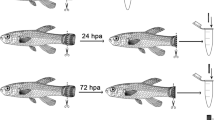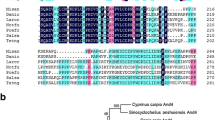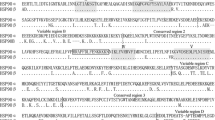Abstract
Urodele amphibians and teleost fish are capable of nearly perfect regeneration of lost appendages. The fin constitutes an important model for studying the molecular basis of tissue regeneration. It has been known that heat shock protein 60 (Hsp60) is a multifunctional protein of the heat shock protein family. The purpose of this study is to investigate the role of hsp60 as a part of a stress response system after fin injury or in fin regeneration. We firstly cloned full-length cDNA of hsp60 from Misgurnus anguillicaudatus (designated as MaHsp60) by RACE method. The cDNA contains a 83-bp 5′UTR, a 1,728-bp open reading frame encoding 492 amino acids and a 542-bp 3′UTR (Accession No.: KF537340). The phylogenetic tree shows that the MaHsp60 fits within the hsp60 clade. Then quantitative RT-PCR detected that MaHsp60 began to increase rapidly its expression at 1 dpa and reached its peak at 2 dpa. Next, spatial distribution analysis of MaHsp60 in fins showed that MaHsp60 located mainly in the deeper layer of regenerated epidermis when MaHsp60 expressed most. After the MaHsp60 had been cloned into the pET-32a vector, SDS-PAGE analysis confirmed that the MaHsp60 protein was efficiently expressed in Escherichia coli BL21 and adjustable with the temperature. These findings have revealed that MaHsp60, a highly conserved gene during vertebrate evolution as well as related to stress response, is involved in the formation of wound epidermis which occurs as the first phase of fin regeneration after fin amputation in caudal fin regeneration.






Similar content being viewed by others
References
Zhang J, Wagh P, Guay D, Sanchez-Pulido L, Akimenko MA (2010) Loss of fish actinotrichia proteins and the fin-to-limb transition. Nature 466:234–237
Azevedo AS, Grotek B, Jacinto A, Weidinger G, Saude L (2011) The regenerative capacity of the zebrafish caudal fin is not affected by repeated amputations. PLoS ONE 6:1–8
Iovine M (2007) Conserved mechanisms regulate outgrowth in zebrafish fins. Nat Chem Biol 10:613–618
Iovine MK, Johnson SL (2000) Genetic analysis of isometric growth control mechanisms in the zebrafish caudal fin. Genetics 155:1321–1329
Akimenko MA, Manuel MB, Jose B, Jacqueline G (2003) Old questions, new tools, and some answers to the mystery of fin regeneration. Dev Dyn 226:190–201
Becerra J, Montes GS, Bexiga SRR, Junqueira LCU (1983) Structure of the tail fin in teleosts. Cell Tissue Res 230:127–137
Santos-Ruiz L, Santamaria JA, Ruiz-Sanchez J, Becerra J (2002) Cell proliferation during blastema formation in the regenerating teleost fin. Dev Dyn 223:262–272
Shao J, Chen D, Ye Q, Cui J, Li Y, Li L (2011) Tissue regeneration after injury in adult zebrafish: the regenerative potential of the caudal fin. Dev Dyn 240:1271–1277
Bhaja KP, Lucille J, Patricia T, Amanda S, Marie-Andree A (2004) Screen for genes differentially expressed during regeneration of the zebrafish caudal fin. Dev Dyn 231:527–541
Nozomi Y, Takashi I, Akira K, Atsushi K (2009) Gene expression and functional analysis of zebrafish larval fin fold regeneration. Dev Biol 325:71–81
Feder ME, Hofmann GE (1999) Heat-shock proteins, molecular chaperones, and the stress response: evolutionary and ecological physiology. Annu Rev Physiol 61:243–282
Marcel T, Catherine J, Sophie V (2000) Zebrafish Hsp40 and Hsc70 genes are both induced during caudal fin regeneration. Mech Dev 99:183–186
Livak KJ, Schmittgen TD (2001) Analysis of relative gene expression data using real-time quantitative PCR and the 2 (-delta delta C (T)) method. Methods 25:402–408
Poss KD, Shen J, Nechiporuk A, McMahon G, Thisse B, Thisse C, Keating MT (2000) Roles for Fgf signaling during zebrafish fin regeneration. Dev Biol 222:347–358
Poss KD, Keating MT, Nechiporuk A (2003) Tales of regeneration in zebrafish. Dev Dyn 226:202–210
Manuel MB, Carmen M (2010) Dermoskeleton morphogenesis in zebrafish fins. Dev Dyn 239:2779–2794
Tamara LT, Jill AF, Robert LT (2010) Molecular signaling networks that choreograph epimorphic fin regeneration in zebrafish—a mini-review. Gerontology 56:231–240
Ranford JC, Coates ARM, Henderson B (2000) Chaperonins are cell-signalling proteins: the unfolding biology of molecular chaperones. Expert Rev Mol Med 2:1–17
Brocchieri L, Karlin S (2000) Conservation among HSP60 sequences in relation to structure, function, and evolution. Protein Sci 9:476–486
Duran I, Mari-Beffa M, Santamaria JA, Becerra J, Santos-Ruiz L (2011) Actinotrichia collagens and their role in fin formation. Dev Biol 354:160–172
Chablais F, Jazwinska A (2010) IGF signaling between blastema and wound epidermis is required for fin regeneration. Development 137:871–879
Wood A, Thorogood P (1984) An analysis of in vivo cell migration during teleost fin morphogenesis. J Cell Sci 66:205–222
Mercader N (2007) Early steps of paired fin development in zebrafish compared with tetrapod limb development. Dev Growth Differ 49:421–437
Rosella C, Andrea D, Pierluca P, Mauro C, Daniela V (2004) Expression of 60 kDa heat shock protein (Hsp60) on plasma membrane of Daudi cells. Mol Cell Biochem 259:1–7
Cha IS, Kwon J, Park SB, Jang HB, Nho SW, Kim YK, Hikima J, Aoki T, Jung TS (2013) Heat shock protein profiles on the protein and gene expression levels in olive flounder kidney infected with Streptococcus parauberis. Fish Shellfish Immunol 34:1455–1462
Anju B, Piyush KP, Sarada SKS, Mustoori S (2010) Effect of adjuvants on immune response and protective immunity elicited by recombinant Hsp60 (GroEL) of Salmonella typhi against S. typhi infection. Mol Cell Biochem 337:213–221
Chow AM, Beraud E, Tang DW, Ferrier-Pagès C, Brown IR (2012) Hsp60 protein pattern in coral is altered by environmental changes in light and temperature. Comp Biochem Physiol A 161:349–353
Acknowledgments
This work is supported by Grants from the Natural Science Foundation of Henan Province (No. 112300410275), Scientific Research Project Fund of the Education department of Henan Province (No. 2011B180030), and Youth Foundation of Henan Normal University (No. 2012QK17).
Author information
Authors and Affiliations
Corresponding author
Rights and permissions
About this article
Cite this article
Li, L., Nan, P., Zhai, S. et al. Molecular cloning, characterization, and expression of hsp60 in caudal fin regeneration of Misgurnus anguillicaudatus . Mol Cell Biochem 387, 143–150 (2014). https://doi.org/10.1007/s11010-013-1879-0
Received:
Accepted:
Published:
Issue Date:
DOI: https://doi.org/10.1007/s11010-013-1879-0




